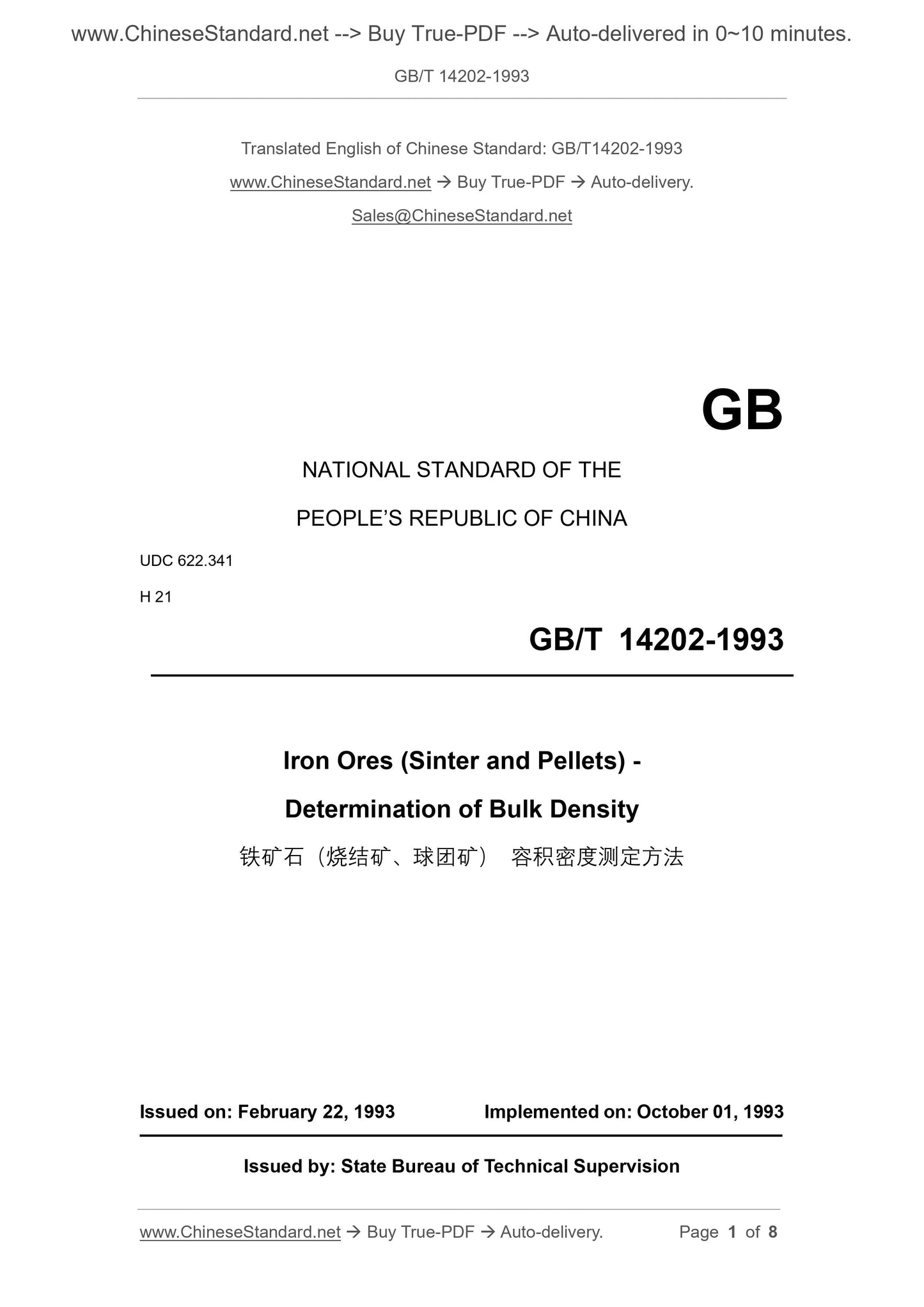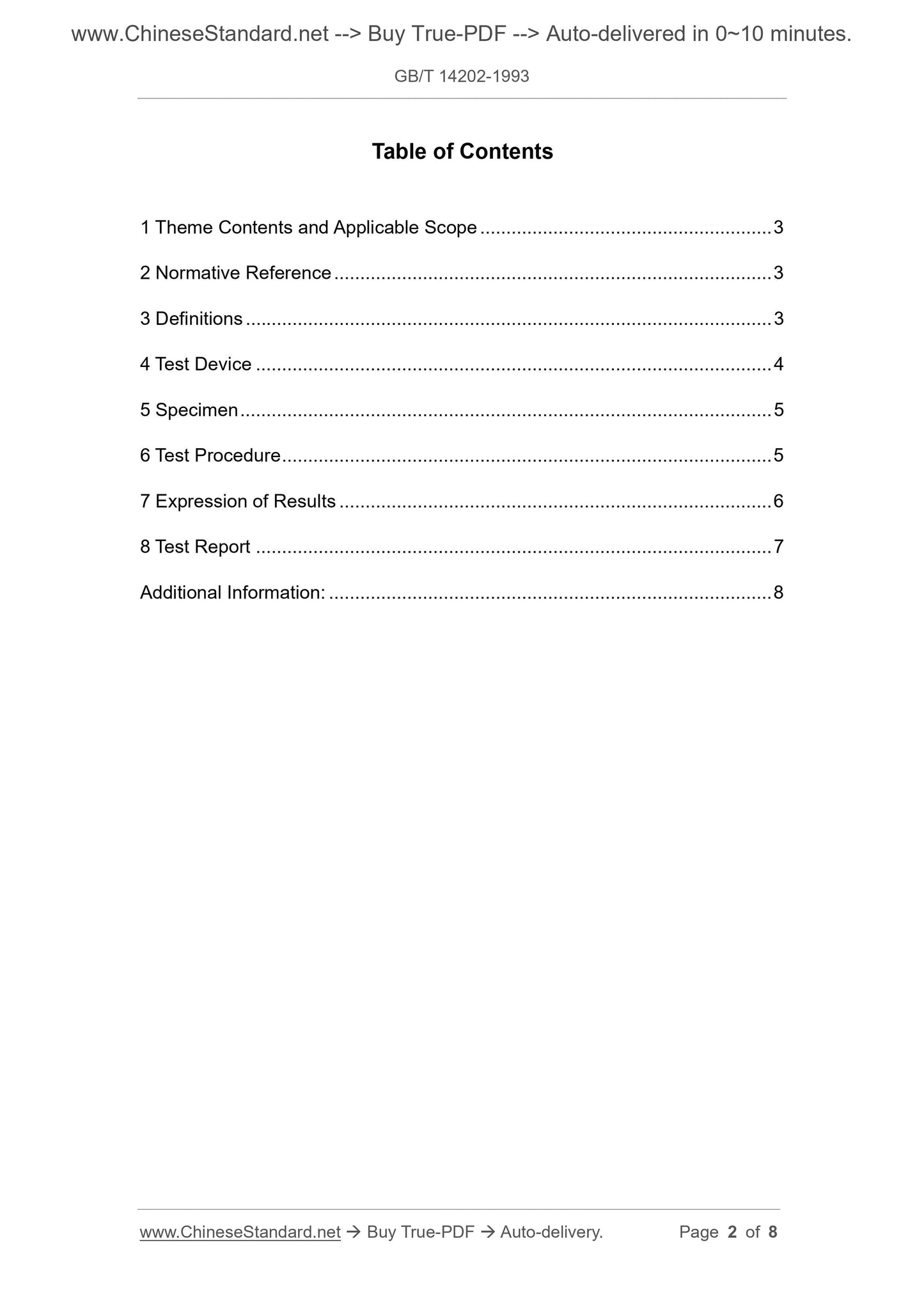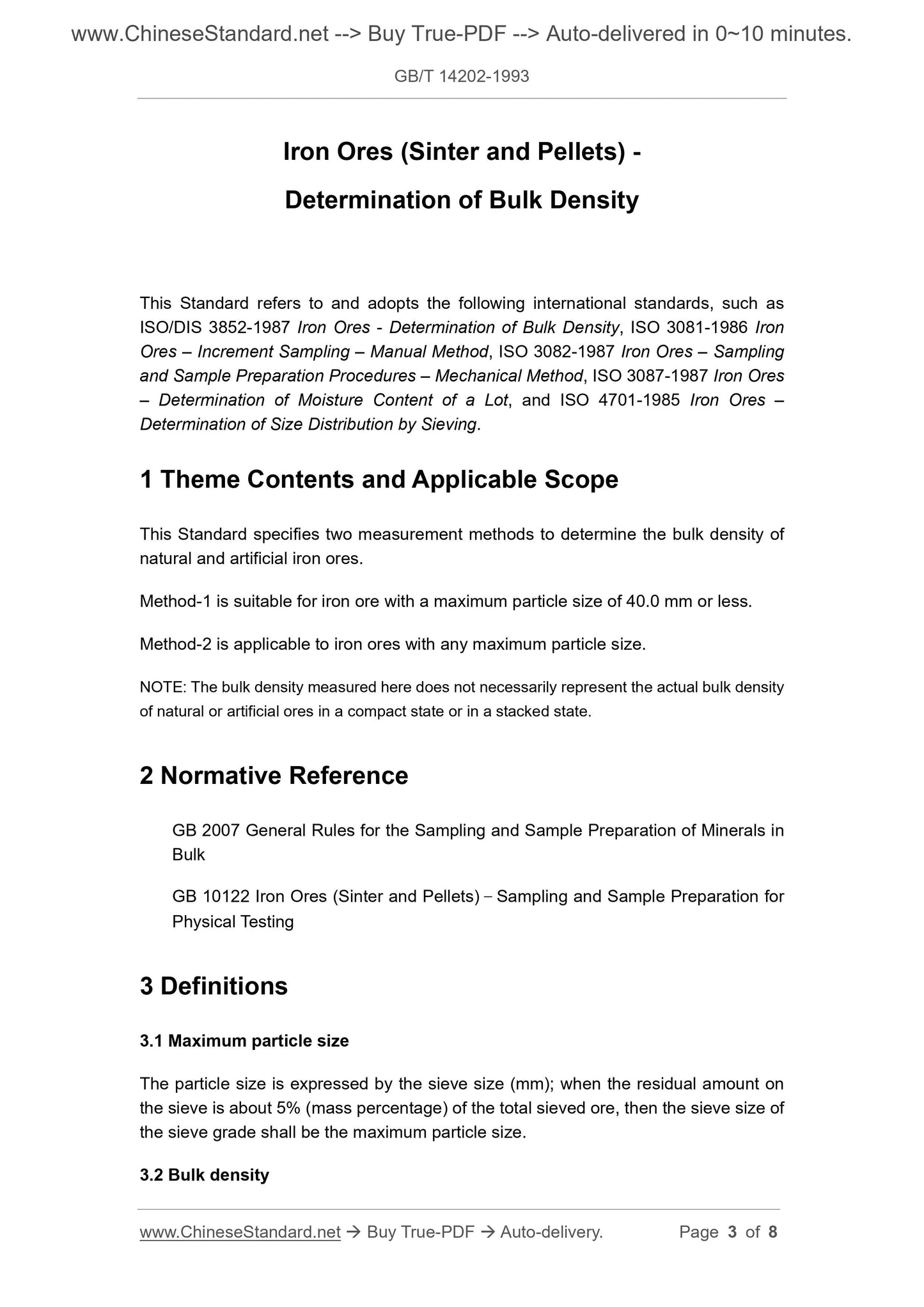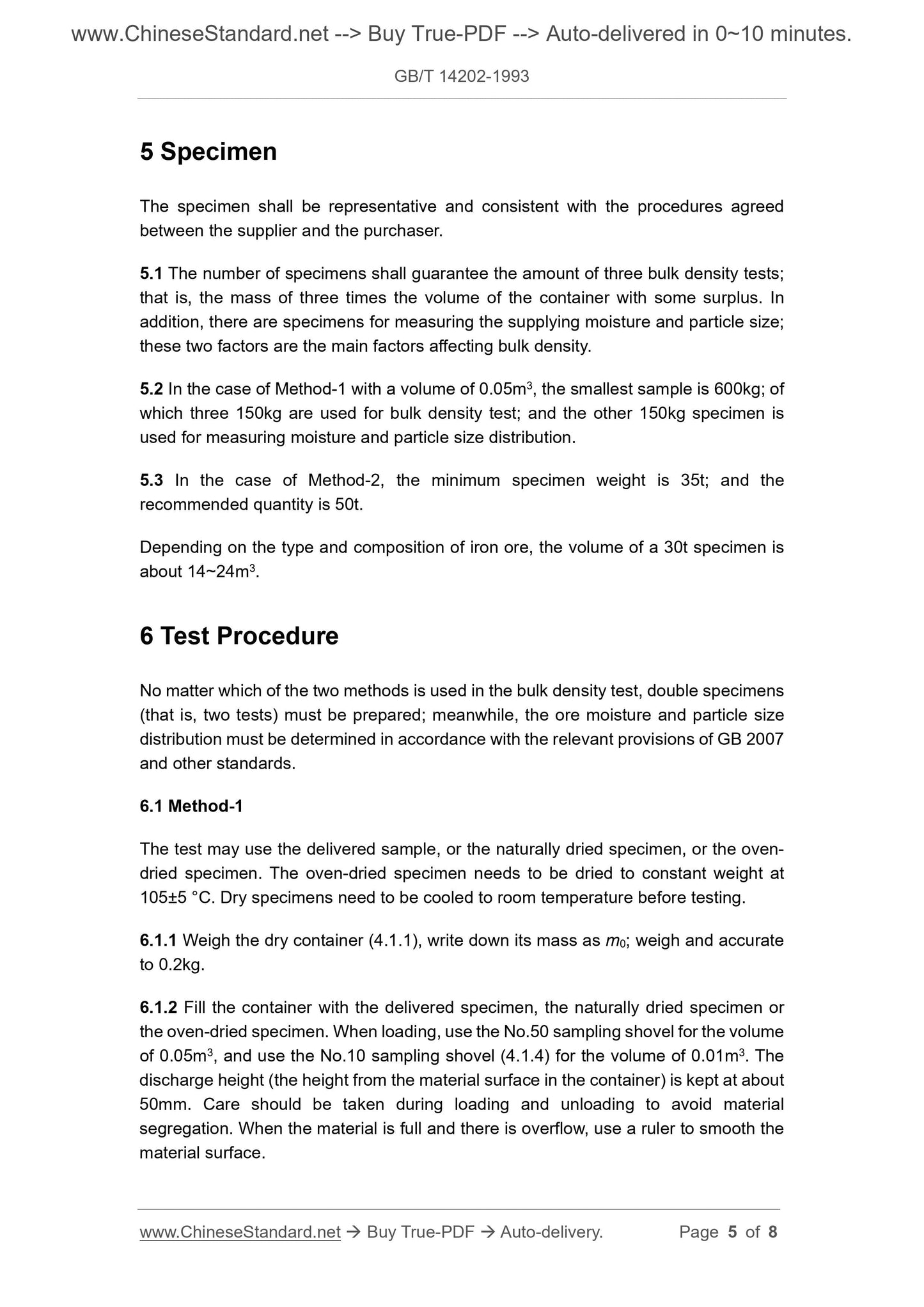1
/
of
4
PayPal, credit cards. Download editable-PDF and invoice in 1 second!
GB/T 14202-1993 English PDF (GBT14202-1993)
GB/T 14202-1993 English PDF (GBT14202-1993)
Regular price
$165.00 USD
Regular price
Sale price
$165.00 USD
Unit price
/
per
Shipping calculated at checkout.
Couldn't load pickup availability
Delivery: 3 seconds. Download true-PDF + Invoice.
Get QUOTATION in 1-minute: Click GB/T 14202-1993
Historical versions: GB/T 14202-1993
Preview True-PDF (Reload/Scroll if blank)
GB/T 14202-1993: Iron ores (sinter and pellets). Determination of bulk density
GB/T 14202-1993
GB
NATIONAL STANDARD OF THE
PEOPLE’S REPUBLIC OF CHINA
UDC 622.341
H 21
Iron Ores (Sinter and Pellets) -
Determination of Bulk Density
ISSUED ON: FEBRUARY 22, 1993
IMPLEMENTED ON: OCTOBER 01, 1993
Issued by: State Bureau of Technical Supervision
Table of Contents
1 Theme Contents and Applicable Scope ... 3
2 Normative Reference ... 3
3 Definitions ... 3
4 Test Device ... 4
5 Specimen ... 5
6 Test Procedure ... 5
7 Expression of Results ... 6
8 Test Report ... 7
Additional Information: ... 8
Iron Ores (Sinter and Pellets) -
Determination of Bulk Density
This Standard refers to and adopts the following international standards, such as
ISO/DIS 3852-1987 Iron Ores - Determination of Bulk Density, ISO 3081-1986 Iron
Ores – Increment Sampling – Manual Method, ISO 3082-1987 Iron Ores – Sampling
and Sample Preparation Procedures – Mechanical Method, ISO 3087-1987 Iron Ores
– Determination of Moisture Content of a Lot, and ISO 4701-1985 Iron Ores –
Determination of Size Distribution by Sieving.
1 Theme Contents and Applicable Scope
This Standard specifies two measurement methods to determine the bulk density of
natural and artificial iron ores.
Method-1 is suitable for iron ore with a maximum particle size of 40.0 mm or less.
Method-2 is applicable to iron ores with any maximum particle size.
NOTE: The bulk density measured here does not necessarily represent the actual bulk density
of natural or artificial ores in a compact state or in a stacked state.
2 Normative Reference
GB 2007 General Rules for the Sampling and Sample Preparation of Minerals in
Bulk
GB 10122 Iron Ores (Sinter and Pellets)-Sampling and Sample Preparation for
Physical Testing
3 Definitions
3.1 Maximum particle size
The particle size is expressed by the sieve size (mm); when the residual amount on
the sieve is about 5% (mass percentage) of the total sieved ore, then the sieve size of
the sieve grade shall be the maximum particle size.
3.2 Bulk density
5 Specimen
The specimen shall be representative and consistent with the procedures agreed
between the supplier and the purchaser.
5.1 The number of specimens shall guarantee the amount of three bulk density tests;
that is, the mass of three times the volume of the container with some surplus. In
addition, there are specimens for measuring the supplying moisture and particle size;
these two factors are the main factors affecting bulk density.
5.2 In the case of Method-1 with a volume of 0.05m3, the smallest sample is 600kg; of
which three 150kg are used for bulk density test; and the other 150kg specimen is
used for measuring moisture and particle size distribution.
5.3 In the case of Method-2, the minimum specimen weight is 35t; and the
recommended quantity is 50t.
Depending on the type and composition of iron ore, the volume of a 30t specimen is
about 14~24m3.
6 Test Procedure
No matter which of the two methods is used in the bulk density test, double specimens
(that is, two tests) must be prepared; meanwhile, the ore moisture and particle size
distribution must be determined in accordance with the relevant provisions of GB 2007
and other standards.
6.1 Method-1
The test may use the delivered sample, or the naturally dried specimen, or the oven-
dried specimen. The oven-dried specimen needs to be dried to constant weight at
105±5 °C. Dry specimens need to be cooled to room temperature before testing.
6.1.1 Weigh the dry container (4.1.1), write down its mass as m0; weigh and accurate
to 0.2kg.
6.1.2 Fill the container with the delivered specimen, the naturally dried specimen or
the oven-dried specimen. When loading, use the No.50 sampling shovel for the volume
of 0.05m3, and use the No.10 sampling shovel (4.1.4) for the volume of 0.01m3. The
discharge height (the height from the material surface in the container) is kept at about
50mm. Care should be taken during loading and unloading to avoid material
segregation. When the material is full and there is overflow, use a ruler to smooth the
material surface.
Get QUOTATION in 1-minute: Click GB/T 14202-1993
Historical versions: GB/T 14202-1993
Preview True-PDF (Reload/Scroll if blank)
GB/T 14202-1993: Iron ores (sinter and pellets). Determination of bulk density
GB/T 14202-1993
GB
NATIONAL STANDARD OF THE
PEOPLE’S REPUBLIC OF CHINA
UDC 622.341
H 21
Iron Ores (Sinter and Pellets) -
Determination of Bulk Density
ISSUED ON: FEBRUARY 22, 1993
IMPLEMENTED ON: OCTOBER 01, 1993
Issued by: State Bureau of Technical Supervision
Table of Contents
1 Theme Contents and Applicable Scope ... 3
2 Normative Reference ... 3
3 Definitions ... 3
4 Test Device ... 4
5 Specimen ... 5
6 Test Procedure ... 5
7 Expression of Results ... 6
8 Test Report ... 7
Additional Information: ... 8
Iron Ores (Sinter and Pellets) -
Determination of Bulk Density
This Standard refers to and adopts the following international standards, such as
ISO/DIS 3852-1987 Iron Ores - Determination of Bulk Density, ISO 3081-1986 Iron
Ores – Increment Sampling – Manual Method, ISO 3082-1987 Iron Ores – Sampling
and Sample Preparation Procedures – Mechanical Method, ISO 3087-1987 Iron Ores
– Determination of Moisture Content of a Lot, and ISO 4701-1985 Iron Ores –
Determination of Size Distribution by Sieving.
1 Theme Contents and Applicable Scope
This Standard specifies two measurement methods to determine the bulk density of
natural and artificial iron ores.
Method-1 is suitable for iron ore with a maximum particle size of 40.0 mm or less.
Method-2 is applicable to iron ores with any maximum particle size.
NOTE: The bulk density measured here does not necessarily represent the actual bulk density
of natural or artificial ores in a compact state or in a stacked state.
2 Normative Reference
GB 2007 General Rules for the Sampling and Sample Preparation of Minerals in
Bulk
GB 10122 Iron Ores (Sinter and Pellets)-Sampling and Sample Preparation for
Physical Testing
3 Definitions
3.1 Maximum particle size
The particle size is expressed by the sieve size (mm); when the residual amount on
the sieve is about 5% (mass percentage) of the total sieved ore, then the sieve size of
the sieve grade shall be the maximum particle size.
3.2 Bulk density
5 Specimen
The specimen shall be representative and consistent with the procedures agreed
between the supplier and the purchaser.
5.1 The number of specimens shall guarantee the amount of three bulk density tests;
that is, the mass of three times the volume of the container with some surplus. In
addition, there are specimens for measuring the supplying moisture and particle size;
these two factors are the main factors affecting bulk density.
5.2 In the case of Method-1 with a volume of 0.05m3, the smallest sample is 600kg; of
which three 150kg are used for bulk density test; and the other 150kg specimen is
used for measuring moisture and particle size distribution.
5.3 In the case of Method-2, the minimum specimen weight is 35t; and the
recommended quantity is 50t.
Depending on the type and composition of iron ore, the volume of a 30t specimen is
about 14~24m3.
6 Test Procedure
No matter which of the two methods is used in the bulk density test, double specimens
(that is, two tests) must be prepared; meanwhile, the ore moisture and particle size
distribution must be determined in accordance with the relevant provisions of GB 2007
and other standards.
6.1 Method-1
The test may use the delivered sample, or the naturally dried specimen, or the oven-
dried specimen. The oven-dried specimen needs to be dried to constant weight at
105±5 °C. Dry specimens need to be cooled to room temperature before testing.
6.1.1 Weigh the dry container (4.1.1), write down its mass as m0; weigh and accurate
to 0.2kg.
6.1.2 Fill the container with the delivered specimen, the naturally dried specimen or
the oven-dried specimen. When loading, use the No.50 sampling shovel for the volume
of 0.05m3, and use the No.10 sampling shovel (4.1.4) for the volume of 0.01m3. The
discharge height (the height from the material surface in the container) is kept at about
50mm. Care should be taken during loading and unloading to avoid material
segregation. When the material is full and there is overflow, use a ruler to smooth the
material surface.
Share








